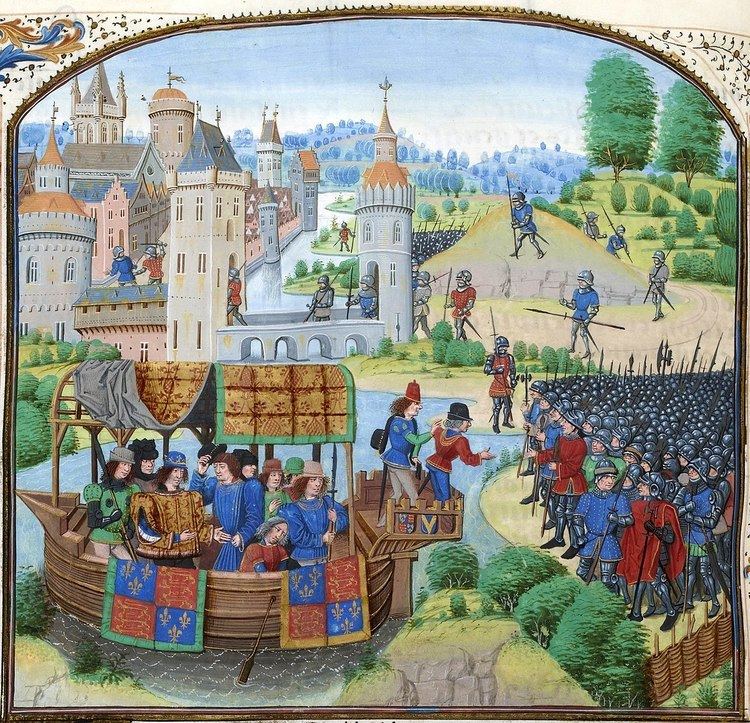 | ||
Popular revolts in late medieval Europe were uprisings and rebellions by (typically) peasants in the countryside, or the bourgeois in towns, against nobles, abbots and kings during the upheavals of the 14th through early 16th centuries, part of a larger "Crisis of the Late Middle Ages". Although sometimes known as Peasant Revolts, the phenomenon of popular uprisings was of broad scope and not just restricted to peasants. In Central Europe and the Balkan region, these rebellions expressed, and helped cause, a political and social disunity paving the way for the expansion of the Ottoman Empire.
Contents
Background
Before the 14th century, popular uprisings (such as uprisings at a manor house against an unpleasant overlord), though not unknown, tended to operate on a local scale. This changed in the 14th and 15th centuries when new downward pressures on the poor resulted in mass movements of popular uprisings across Europe. To provide an example of how common and widespread these movements became, Germany between 1336 and 1525 witnessed no fewer than sixty instances of militant peasant unrest.
Most of the revolts expressed the desire of those below to share in the wealth, status, and well-being of those more fortunate. In the end, they were almost always defeated and the nobles ruled the day. A new attitude emerged in Europe, that "peasant" was a pejorative concept, it was something separate, and seen in a negative light, from those who had wealth and status. This was an entirely new social stratification from earlier times when society had been based on the three orders, those who work, those who pray, and those who fight, when being a peasant meant being next to God, just like the other orders. Now peasants gained an image as almost sub-human.
Causes
There were five main reasons for these mass uprisings: 1) an increasing gap between the wealthy and poor, 2) declining incomes of the poor, 3) rising inflation and taxation, 4) the external crises of famine, plague and war, and 5) religious backlashes.
The first reason was that the social gap between rich and poor had become more extreme. The origins of this change can be traced to the 12th century and the rise of the concept of nobility. Dress, behaviour, manners, courtesy, speech, diet, education — all became part of the noble class, making them distinct from others. By the 14th century the nobles had indeed become very different in their behaviour, appearance and values from those "beneath".
The second reason was a crisis for the nobles with declining income. By 1285 inflation had become rampant (in part due to population pressures) and some nobles charged rent based on customary fixed rates, based on the feudal system, so as the price of goods and services rose from inflation, the income of those nobles remained stagnant, effectively dropping. To make matters worse, the nobles had become accustomed to a more luxurious lifestyle that required more money. To address this, nobles illegally raised rents, cheated, stole, and sometimes resorted to outright violence to take what they wanted.
Third, kings who needed money to finance wars resorted to devaluing currency by cutting silver and gold coins with less precious metal, which resulted in increased inflation and in the end, increased tax rates.
Fourth, the 14th century crisis of famine, plague, and war put additional pressures on those at the bottom. The plague drastically reduced the numbers of people who were workers and producing the wealth.
Finally, layered on top of this was a popular ideological view of the time that property, wealth and inequality was against the teachings of God, as expressed through the teachings of the Franciscans. The sentiment of the time was probably best expressed by preacher John Ball during the English Peasant Revolt when he said, "When Adam delved and Eve span, who was then the gentleman?", criticizing economic inequality as human-made rather than a creation of God.
Notable rural revolts
Notable urban revolts
Terminology
Different historians will use different terms to describe these events.
Peasant
The word peasant, since the 14th century (or even before), has a pejorative meaning and is not a neutral term. However, it was not always that way; peasants were once viewed as pious and seen with respect and pride. Life was hard for peasants, but life was hard for everyone. As nobles increasingly lived better quality lives, there arose a new consciousness of those on top and those on bottom, and the sense that being a peasant was not a position of equality. This new consciousness coincided with the popular uprisings of the 14th century.
Research by Rodney Hilton in the 1970s showed that the English Peasant Revolt of 1381 (or Great Rising) was led not by peasants, but by those who would be the most affected by increased taxation: the merchants who were neither wealthy, but not poor either. Indeed, these revolts were often accompanied by landless knights, excommunicated clerics and other members of society who might find gain or have reason to rebel. Although these were popular revolts, they were often organized and led by people who would not have considered themselves peasants.
Peasants is typically a term used for rural agrarian poor while many uprisings occurred within towns and cities by tradesmen, thus the term is not fully encompassing of events as a whole for the period.
For historical writing purposes, many modern historians will use the word peasant with care and respect, choosing other phrases such as "Popular" or "from below" or "grassroots", although in some countries in central and eastern Europe where serfdom continued up to the 19th century in places, the word peasant is still used by some historians as the main description of these events.
